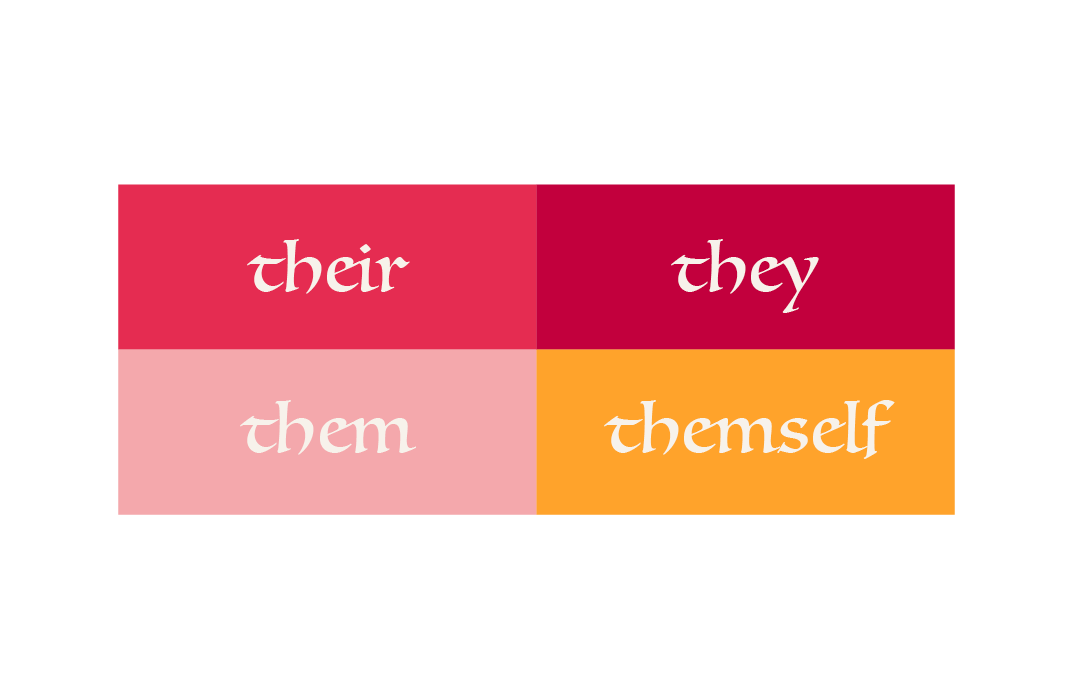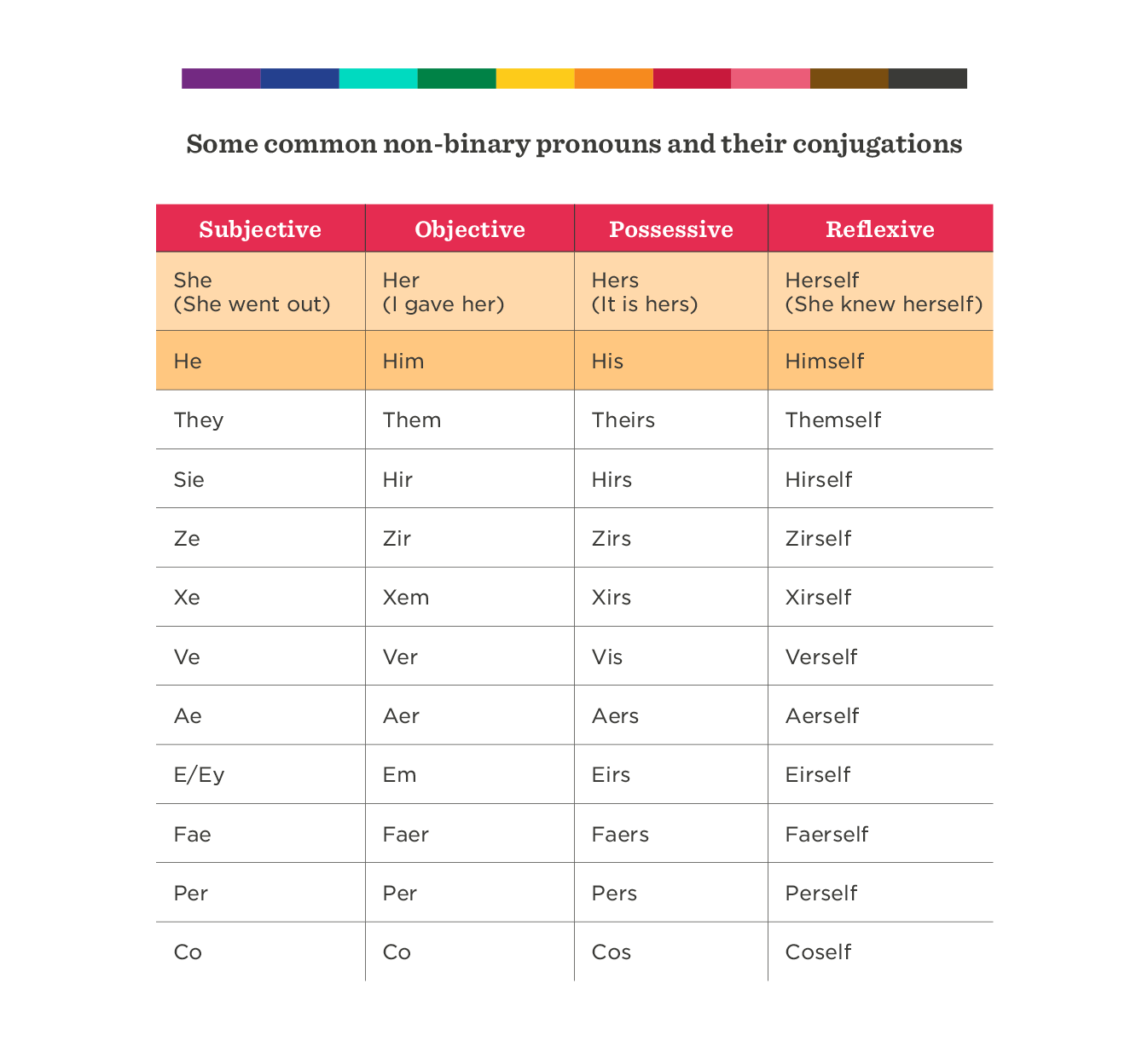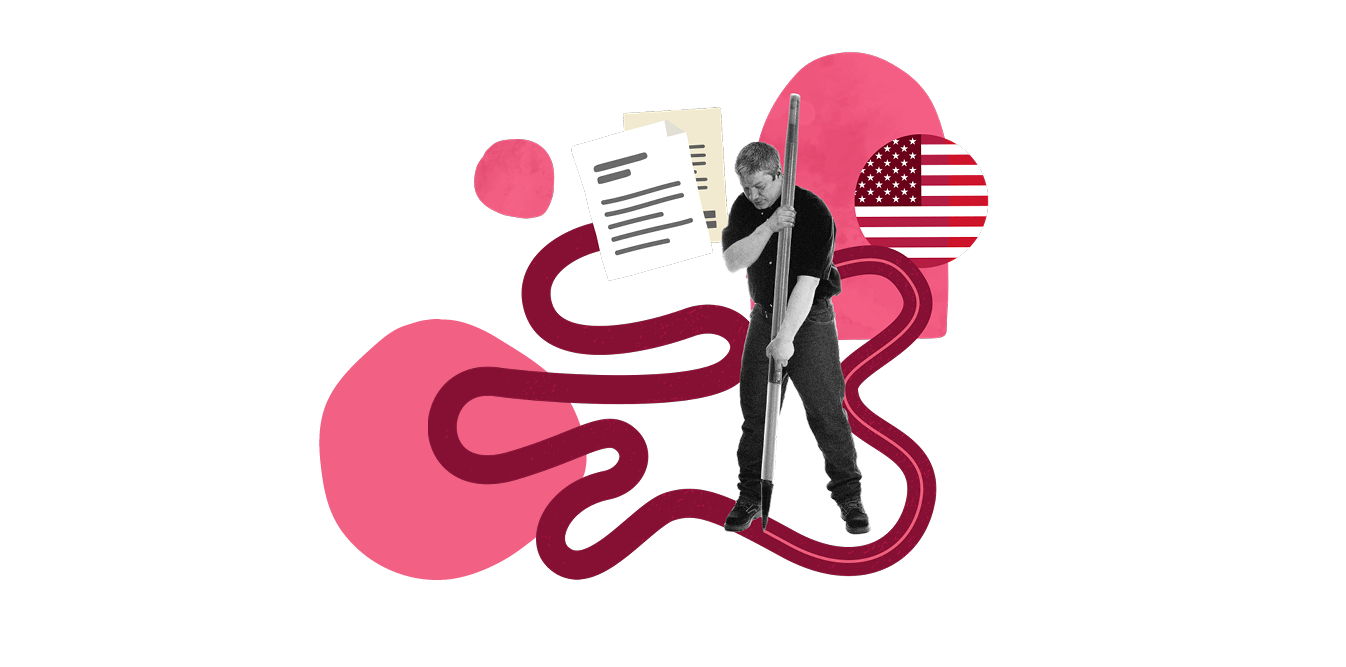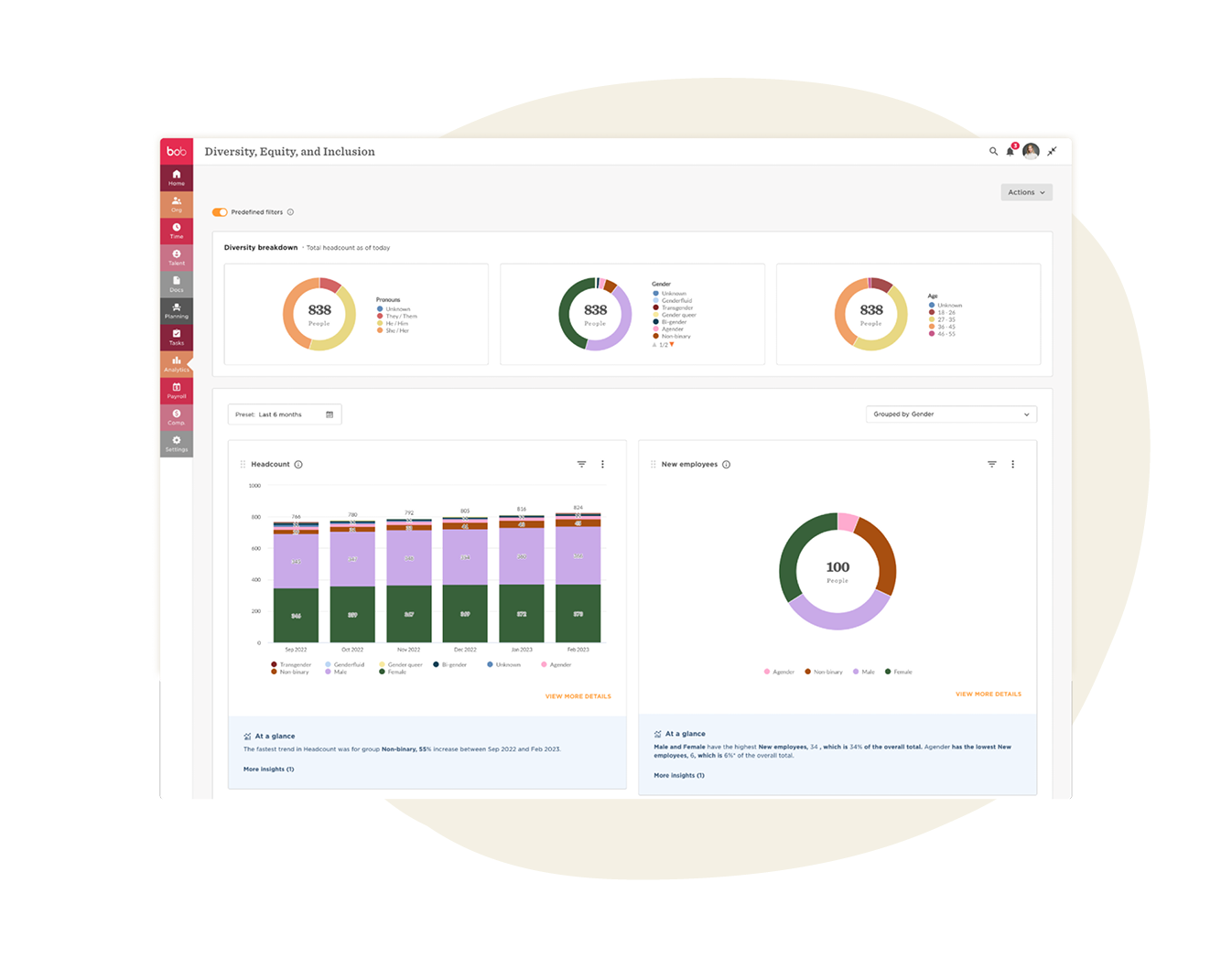Introduction
One of the most significant challenges for modern HR professionals is spearheading genuinely inclusive work environments attuned to non-binary gender inclusion. This means implementing organizational programs that reinforce correct gender pronoun usage, celebrate diversity, and support individuals from all backgrounds and identities.
Supporting employees who use non-binary pronouns—pronouns that go beyond the traditional “he and she”—is a critical part of this work.
This guide reviews non-binary gender pronouns, discusses who uses them, and explores how you can use modern HR tech to promote initiatives that support non-binary team members.

What are pronouns, and why do they matter?
For the modern HR leader, understanding the nuances and the importance of correct pronoun usage is paramount to fostering a healthy and inclusive workplace environment for everyone—not just people who live outside of the traditional, Western gender binary.
A (very) brief history of gender pronouns
In English, gender pronouns are third-person gender identifiers.
Most people are familiar with the singular masculine (he/him/his) and feminine (she/her/hers) gender pronouns in English. When these are the only options for referring to someone in the third person, it imposes a binary language system on the complex topic of gender identity. It only recognizes men and women and excludes anyone who identifies outside the gender binary or as agender.
But language is constantly evolving—and evolving back—in pursuit of ways to express complex ideas. In fact, the Oxford English Dictionary traces the first use of the gender-neutral singular pronoun “they” back to the 14th century. According to an article in The Atlantic, while “people tend to think of” gender-neutral pronouns like “they, Mx., and hir as relatively recent inventions … English speakers have been looking for better ways to talk about gender for a very long time.”

Who uses gender-neutral pronouns?
For people who identify outside the traditional gender binary, using gender-neutral pronouns or pronouns that fit their identity can be incredibly empowering. It’s important to understand that people’s pronouns are not about a choice they make or about a specific preference. It’s about aligning their pronouns with how they identify or—more simply—with who they are.
As Devin-Norelle, a non-binary model, advocate, and writer points out in the LGBTQIA+ magazine, Them, it’s important to know that “someone’s pronouns are never ‘preferred.’ Activists remind us that by calling pronouns ‘preferred,’ it would suggest that they are not real or should not be respected. Pronouns are just … pronouns. They are not preferred.”
But, to really understand why using people’s pronouns correctly is important, we first have to understand different gender identities.
What are non-binary genders?
When someone says they’re non-binary, it means that they don’t identify as a man or a woman. They may identify as both, neither, or something in between these binary genders.
People who identify as non-binary may also identify as gender-nonconforming, gender-fluid, gender-expansive, genderqueer, or two-spirit. They may also identify as transgender, though not all non-binary people consider themselves trans.

According to Pew research from 2022, “5.1% of adults younger than 30 are trans or nonbinary,” and 44 percent of adults in the US say they know someone who identifies as trans. Another 20 percent say they know someone who is non-binary.
Incorrectly addressing someone with the wrong pronoun is hurtful and 100 percent avoidable. But there’s resistance to getting it right. According to Pew research from 2021, “[h]alf of Americans say they would feel very or somewhat comfortable using a gender-neutral pronoun to refer to someone if they were asked to do so, while 48% would feel very or somewhat uncomfortable doing so.”
As people become more open about their gender identity, it’s critical to avoid misgendering them (e.g., using the wrong pronouns) and to foster awareness, acceptance, and inclusion in the workplace. Using the correct pronouns for someone is just like getting their name right—whether or not you personally feel comfortable with the idea has no impact on the importance of getting it right.
How can people avoid misgendering someone?
The battle for correct gender pronoun usage is ongoing for transgender, non-binary, and gender-nonconforming people—which is why getting people’s pronouns right in the workplace is crucial. And it’s up to HR to make misgendering people—accidentally or intentionally—in the workplace a thing of the past.
Beyond discomfort and unintentional misgendering, deliberate misgendering is a form of harassment and discrimination. It’s important to be sensitive to the fact that in addition to harming your organizational culture and reputation, misgendering people can profoundly affect non-binary and trans individuals’ mental wellbeing—to the point of contributing to self-harm or suicidality.
Non-binary individuals have the right to be referred to by their correct pronouns, especially in the workplace. While this may not be about legal compliance in every case, it’s always about respect and equality in your workplace community. It’s about fostering an environment where everyone is encouraged and empowered to bring their most authentic selves to work every day without fear of judgment or reprisal.
On the most basic level, the first step to avoid misgendering people in the workplace is to include correct pronoun usage in your DE&I policies. Any effective DE&I policy includes dedicated guidelines on:
- Training colleagues, managers, and executives on non-binary pronouns
- Normalizing pronoun usage and inclusive language more broadly across the entire organization
- Protecting non-binary team members, including specific policies on how to handle misgendering people and other forms of harassment and discrimination
- Supporting employees who wish to transition and/or change their pronouns at work
Organizations that take DEI&B seriously make putting processes and policies in place to accommodate non-binary and transgender team members a top priority.

6 ways to promote correct gender pronoun usage
Supporting trans and non-binary people is critical to making them feel safe at work. HR leaders can move the dial here and propel a genuine shift in company culture through inclusive actions supported by DE&I policies.
1. Promote awareness around non-binary inclusion
One of the primary reasons people may struggle to use non-binary pronouns is because they’ve never met anyone who uses them or identifies as transgender or non-binary. They may also have strong unconscious biases because of this. The first step to overcoming discomfort and unconscious bias is promoting awareness and understanding between people.
Work with company leadership to make promoting awareness around trans and non-binary gender identities a policy and a continuous practice across all sites. Start with telling relatable, human stories about the challenges trans and non-binary professionals face every day—not just during Pride Month but year-round.
The reality is that trans and non-binary professionals experience discrimination in hiring and promotional practices. This has led to disproportionate levels of unemployment, poverty, and homelessness for members of the trans and non-binary communities.
While more people have felt empowered to come out publicly as trans or non-binary, research by McKinsey shows that “[t]ransgender people continue to face stigma and discrimination,” and “those struggles carry over to the workforce where transgender people are overall underrepresented.” The same research shows that “nearly 30 percent of transgender people in the United States are not in the workforce and are twice as likely as the cisgender population to be unemployed.”
In other words, while progress is being made on one front, the challenges to being treated equitably and fairly in the workplace are on the rise. HR teams are in a position to champion trans and non-binary acceptance and inclusion through actionable company policies rooted in the principles of diversity, equity, inclusion, and belonging (DEI&B).
2. Practice correct pronoun usage and conjugation
Today, there are many different gender-neutral pronouns. People in the LGBTQIA+ community use the pronouns they feel best represent their authentic selves. For anyone who is new to using gender-neutral pronouns, getting them right takes practice.
There are many gender pronouns non-binary, trans, and gender-nonconforming individuals use—and there are more emerging all the time. For HR to work on trans and non-binary inclusion, the first step is moving beyond defaulting to they/them for non-binary people and encouraging discussion about the full range of gender pronouns, including neopronouns like ze/zir and xe/xim.
This is by no means a comprehensive and complete list of non-binary pronouns, but these are some of the more commonly used.

3. Be mindful of people’s pronouns
As an organization, it’s important to promote the correct usage of gender pronouns, even when you may not know what people’s pronouns are.
Let your people know that it’s always ok to ask what someone’s pronouns are if they don’t know. To make things easier on others, introduce yourself along with your pronouns. For example, when meeting someone for the first time, introduce yourself by saying something like, “Hi, I’m Blake Doe, and my pronouns are they/them. What’s your name, and what are your pronouns?”
If you don’t get a chance to learn what someone’s pronouns are before you find yourself in the middle of a conversation with them, it’s best to use their name. It’s also ok to use they/them pronouns until you know.
Creating opportunities for non-binary individuals to self-identify requires being inclusive of all pronouns from ey to ze. And, if you’ve never heard of a particular pronoun and its conjugations, it’s ok to ask for clarification.
It’s also crucial for organizations to empower people to add their pronouns to their email signatures and social media profiles and to introduce themselves with their pronouns in face-to-face meetings. Of course, it’s also possible that not everyone will want to share their pronouns or would prefer you to assume their pronouns, and that’s OK, too. Encourage people to share their pronouns proactively, but never make it a mandatory exercise.
Making gender pronouns a mandatory field or requirement in your HCM or HRIS can also be discriminatory if someone does not have a pronoun that represents them or if they prefer not to disclose their gender identity. Keep these fields optional, or provide “prefer not to say” options for mandatory compliance requirements like those associated with EEOC reporting in the US.

4. Properly address people who use multiple pronoun sets
Sometimes, people use what’s called rolling pronouns or multiple pronoun sets. For example, someone may use she/they or xe/they. Always ask people what pronouns they’re most comfortable with.
Some people use multiple pronoun sets interchangeably, meaning when you address them or speak about them, you would say something like, “She went to the park to go on their daily run.” Someone else may use single sets of pronouns at one time: “She went to the park to go on her run” or “They went to the park to go on their run.”
No matter how people use their pronouns, it’s important to respect them and use their pronouns correctly—and to correct your mistakes.
5. Use gender-neutral honorific titles
It’s also important to use correct gender-neutral honorific titles in place of titles like Mr., Mrs., Miss, or Ms.
As more people feel comfortable openly identifying as non-binary, trans, or gender-neutral in professional and formal settings, it’s vital for companies to promote the use of gender-neutral honorifics. As an announcement by HSBC explains, “Gender neutral titles allow people who don’t identify as a particular gender, or who don’t want to be identified by gender, to choose the title that works for them.”
While the most commonly used gender-neutral honorific is Mx. (pronounced “mix” or “mux”), there are many in use, and they “can refer to a multitude of gender identities,” according to the LGBTQIA+ magazine Them. Some other gender-neutral honorifics include Mre., Myr., Ind., Msr., Misc., Ser, and Sai.
However, using honorifics is becoming less common, and a lot of people don’t use honorific titles at all. In cases like this, it’s best just to use their name. But, as always, ask people what they’re comfortable with.
6. Correct your mistakes if you accidentally misgender someone
Practicing correct pronoun usage starts with never assuming you know someone’s pronouns before asking. But, even if we know what someone’s pronouns are, we can make mistakes. That’s ok—making mistakes is part of being human.
When you make a mistake, keep it simple: Apologize, correct your mistake, and move on. As explained in Them, “[a]pologizing profusely can draw unnecessary attention to or cause embarrassment for someone who uses gender-neutral pronouns. Just acknowledge your mistake and correct yourself, and then continue on with the conversation.”

Conclusion: Normalizing non-binary pronouns is just one part of the journey to inclusivity
Like employees of any subgroup, trans and non-binary people are not a monolith, and there is no “one size fits all” policy for HR leaders when it comes to adopting gender expansive and inclusive language.
People who identify as trans or non-binary don’t have the privilege of “letting it go” when they are misgendered—and that includes in the workplace. One of the most important ways to promote DE&I policies that are friendly to people of all identities and genders is to normalize the usage of non-binary pronouns across your organization.
It’s every organization’s responsibility, with HR at the helm, to create an inclusive and welcoming environment for everyone—no matter how they identify themselves or which pronouns they use.
This guide serves as a first step to getting DEI&B right, starting with normalizing and reinforcing correct gender pronoun usage. As leaders of workplace culture, HR professionals are in a position to spearhead progressive DEI&B efforts—by working alongside their people, employee resource groups (ERGs), and subject matter experts—and make a positive and lasting impact on people’s lives at work and in society at large.
Recommended For Further Reading
Meet Bob
Gender- and identity-supporting HR tech can help organizations identify areas for improvement on the road to achieving equity and inclusion. While revamping manuals, documentation, processes, and office language to be more inclusive can seem daunting, digital tools can help empower and align your people, creating more opportunities for communication and connection.
Bob helps foster inclusive work cultures
At HiBob, we’ve built a modern HCM that makes people management and creating (and sustaining) an inclusive workplace easy. You can find DE&I tools in Bob’s DE&I dashboard, Reports, Custom Gender Selection, Pronoun selection functionalities, and more. HR professionals can leverage Bob’s people data to help plan events, inclusive accommodations, and accessible facilities, in addition to determining inclusive company policies and training programs.
Custom gender and pronoun selection
In Bob, you can customize and configure fields, and manually add genders and pronouns to drop-down lists to meet your team’s needs. Once you’ve set your list of genders and pronouns, your people can conveniently customize their own user profiles.
Compliance with laws and insurance requirements
We recommend you create separate fields for sex (as required for legal and insurance purposes) and gender, as well as gender pronouns in Bob. This allows companies to comply with local regulations and insurance requirements that still require male-female binary reporting while fully supporting an inclusive culture that allows your people to share and be addressed by their pronouns.
Reports and insights
After your employees have had a chance to update their profiles, you can filter by accurate and relevant details on gender, sex, nationality, age, and more with automated analysis in:
- Surveys
- Demographic data
- Employee Lifecycle Feedback
- Talent groups
- Pay and benefits
- Compensation
DE&I dashboard
Take all the data you’ve collected on people’s age, nationality, ethnicity, pronouns, gender identity, and more and easily track it to make sense of your DE&I efforts with Bob’s DE&I dashboard. These centralized and customizable dashboards provide clear insights into your data, making it easy to be compliant, see how your internal DE&I programs are performing, and pinpoint where you need to improve.

